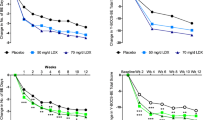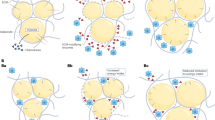Abstract
Objective:
To determine the magnitude and determinants of weight loss in humans exposed to betahistine, a centrally acting histamine-1 (H-1) agonist and partial histamine-3 (H-3) antagonist.
Design:
A multicenter randomized, placebo-controlled dose-ranging weight loss trial with a 12-week treatment period.
Subjects:
Two hundred and eighty-one obese but otherwise healthy participants.
Measurements:
Weight and obesity-related comorbidities at baseline and at the end of the intervention.
Results:
Betahistine, at the doses tested, did not induce significant weight loss. With the exception of headache, no difference in adverse effect profile was noted between placebo and treatment groups. Subgroup analysis revealed that age below 50 years, ethnicity (non-Hispanics) and gender (women) were the strongest predictors of weight loss in this population. When these three factors were combined together, the betahistine 48 mg group (n=23) lost −4.24±3.87 kg, whereas the placebo group (n=25) lost −1.65±2.96 kg during this time period (P=0.005).
Conclusion:
Betahistine, at the doses tested, induced significant weight loss with minimal adverse events only in women below 50 years.
This is a preview of subscription content, access via your institution
Access options
Subscribe to this journal
Receive 12 print issues and online access
$259.00 per year
only $21.58 per issue
Buy this article
- Purchase on Springer Link
- Instant access to full article PDF
Prices may be subject to local taxes which are calculated during checkout





Similar content being viewed by others
References
Bugajski J, Gadek-Michalska A, Bugajski AJ . Nitric oxide and prostaglandin systems in the stimulation of hypothalamic–pituitary–adrenal axis by neurotransmitters and neurohormones. J Physiol Pharmacol 2004; 55: 679–703.
Lecklin A, Etu-Seppälä P, Stark H, Tuomisto L . Effects of intracerebroventricularly infused histamine and selective H1, H2 and H3 agonists on food and water intake and urine flow in Wistar rats. Brain Res 1998; 793: 279–288.
Passani MB, Lin JS, Hancock A, Crochet S, Blandina P . The histamine H3 receptor as a novel therapeutic target for cognitive and sleep disorders. Trends Pharmacol Sci 2004; 25: 618–625.
Morimoto T, Yamamoto Y, Yamatodani A . Brain histamine and feeding behavior. Behav Brain Res 2001; 124: 145–150.
Parsons ME, Ganellin CR . Histamine and its receptors. Br J Pharmacol 2006; 147 (Suppl 1): S127–S135.
Attoub S, Moizo L, Sobhani I, Laigneau JP, Lewin MJ, Bado A . The H3 receptor is involved in cholecystokinin inhibition of food intake in rats. Life Sci 2001; 69: 469–478.
Masaki T, Chiba S, Yasuda T, Noguchi H, Kakuma T, Watanabe T et al. Involvement of hypothalamic histamine H1 receptor in the regulation of feeding rhythm and obesity. Diabetes 2004; 53: 2250–2260.
Wijtmans M, Leurs R, de Esch I . Histamine H3 receptor ligands break ground in a remarkable plethora of therapeutic areas. Expert Opin Investig Drugs 2007; 16: 967–985.
Clineschmidt BV, Lotti VJ . Histamine: intraventricular injection suppresses ingestive behavior of the cat. Arch Int Pharmacodyn Ther 1973; 206: 288–298.
Itowi N, Nagai K, Nakagawa H, Watanabe T, Wada H . Changes in the feeding behavior of rats elicited by histamine infusion. Physiol Behav 1988; 44: 221–226.
Orthen-Gambill N . Antihistaminic drugs increase feeding, while histidine suppresses feeding in rats. Pharmacol Biochem Behav 1988; 31: 81–86.
Sheiner JB, Morris P, Anderson GH . Food intake suppression by histidine. Pharmacol Biochem Behav 1985; 23: 721–726.
Vaziri P, Dang K, Anderson GH . Evidence for histamine involvement in the effect of histidine loads on food and water intake in rats. J Nutr 1997; 127: 1519–1526.
Lecklin A, Tuomisto L, MacDonald E . Metoprine, an inhibitor of histamine N-methyltransferase but not catechol-O-methyltransferase, suppresses feeding in sated and in food deprived rats. Methods Find Exp Clin Pharmacol 1995; 17: 47–52.
Lecklin A, Tuomisto L . The blockade of H 1 receptors attenuates the suppression of feeding and diuresis induced by inhibition of histamine catabolism. Pharmacol Biochem Behav 1998; 59: 753–758.
Doi T, Sakata T, Yoshimatsu H, Machidori H, Kurokawa M, Jayasekara LA et al. Hypothalamic neuronal histamine regulates feeding circadian rhythm in rats. Brain Res 1994; 641: 311–318.
Sakata T, Fukagawa K, Ookuma K, Fujimoto K, Yoshimatsu H, Yamatodani A et al. Hypothalamic neuronal histamine modulates ad libitum feeding by rats. Brain Res 1990; 537: 303–306.
Orthen-Gambill N, Salomon M . FMH-induced decrease in central histamine levels produces increased feeding and body weight in rats. Physiol Behav 1992; 51: 891–893.
Ookuma K, Sakata T, Fukagawa K, Yoshimatsu H, Kurokawa M, Machidori H et al. Neuronal histamine in the hypothalamus suppresses food intake in rats. Brain Res 1993; 628: 235–242.
Canty P, Valentine J, Papworth SJ . Betahistine in peripheral vertigo: a double blind, placebo-controlled, cross-over study of Serc versus placebo. J Laryngol Otol 1981; 95: 687–692.
Fossati A, Barone D, Benvenuti C . Binding affinity profile of betahistine and its metabolites for central histamine receptors of rodents. Pharmacol Res 2001; 43: 389–392.
Arrang JM, Garbarg M, Quach TT, Dam Trung Tuong M, Yeramian E, Schwartz JC . Actions of betahistine at histamine receptors in the brain. Eur J Pharmacol 1985; 111: 73–84.
Jeck-Thole S, Wagner W . Betahistine: a retrospective synopsis of safety data. Drug Safety 2006; 29: 1049–1059.
Food and Nutrition Board. Dietary Reference Intakes for Energy, Carbohydrate, Fiber, Fat, Fatty Acids, Cholesterol, Protein, and Amino Acids (Macronutrients) National Academy Press: Washington DC, 2005.
Mercer LP, Kelley DS, Bufidranj HM, Haq AA, Humphries LL . Gender affects rat's central nervous system histaminergic responses to dietary manipulation. J Nutr 1996; 126: 3128–3135.
Kasaoka S, Kawahara Y, Inoue S, Tsuji M, Kato H, Tsuchiya T et al. Gender effects in dietary histidine-induced anorexia. Nutrition 2005; 21: 855–858.
Bajic D, Hoang QV, Nakajima S, Nakajima Y . Dissociated histaminergic neuron cultures from the tuberomammillary nucleus of rats: culture methods and ghrelin effects. J Neurosci Methods 2004; 132: 177–184.
Sakata T, Yoshimatsu H, Kurokawa M . Hypothalamic neuronal histamine: implications of its homeostatic control of energy metabolism. Nutrition 1997; 13: 403–411.
Nillni EA, Vaslet C, Harris M, Hollenberg A, Bjørbak C, Flier JS . Leptin regulates prothyrotropin-releasing hormone biosynthesis. Evidence for direct and indirect pathways. J Biol Chem 2000; 275: 36124–36133.
Gotoh K, Fukagawa K, Fukagawa T, Noguchi H, Kakuma T, Sakata T et al. Hypothalamic neuronal histamine mediates the thyrotropin-releasing hormone-induced suppression of food intake. J Neurochem 2007; 103: 1102–1110.
Kow LM, Pfaff DW . Mapping of neural and signal transduction pathways for lordosis in the search for estrogen actions on the central nervous system. Behav Brain Res 1998; 92: 169–180.
Zhou J, Lee AW, Devidze N, Zhang Q, Kow LM, Pfaff DW . Histamine-induced excitatory responses in mouse ventromedial hypothalamic neurons: ionic mechanisms and estrogenic regulation. J Neurophysiol 2007; 98: 3143–3152.
Yusuf S, Wittes J, Probstfield J, Tyroler HA . Analysis and interpretation of treatment effects in subgroups of patients in randomized clinical trials. JAMA 1991; 266: 93–98.
Lagakos SW . The challenge of subgroup analyses—reporting without distorting. N Engl J Med 2006; 354: 1667–1669.
Author information
Authors and Affiliations
Corresponding author
Rights and permissions
About this article
Cite this article
Barak, N., Greenway, F., Fujioka, K. et al. Effect of histaminergic manipulation on weight in obese adults: a randomized placebo controlled trial. Int J Obes 32, 1559–1565 (2008). https://doi.org/10.1038/ijo.2008.135
Received:
Revised:
Accepted:
Published:
Issue Date:
DOI: https://doi.org/10.1038/ijo.2008.135
Keywords
This article is cited by
-
Betahistine effects on weight-related measures in patients treated with antipsychotic medications: a double-blind placebo-controlled study
Psychopharmacology (2018)
-
The histamine H3 receptor inverse agonist pitolisant reduces body weight in obese mice
Naunyn-Schmiedeberg's Archives of Pharmacology (2018)
-
Current and Future Drug Targets in Weight Management
Pharmaceutical Research (2011)
-
Cellular bioenergetics as a target for obesity therapy
Nature Reviews Drug Discovery (2010)



